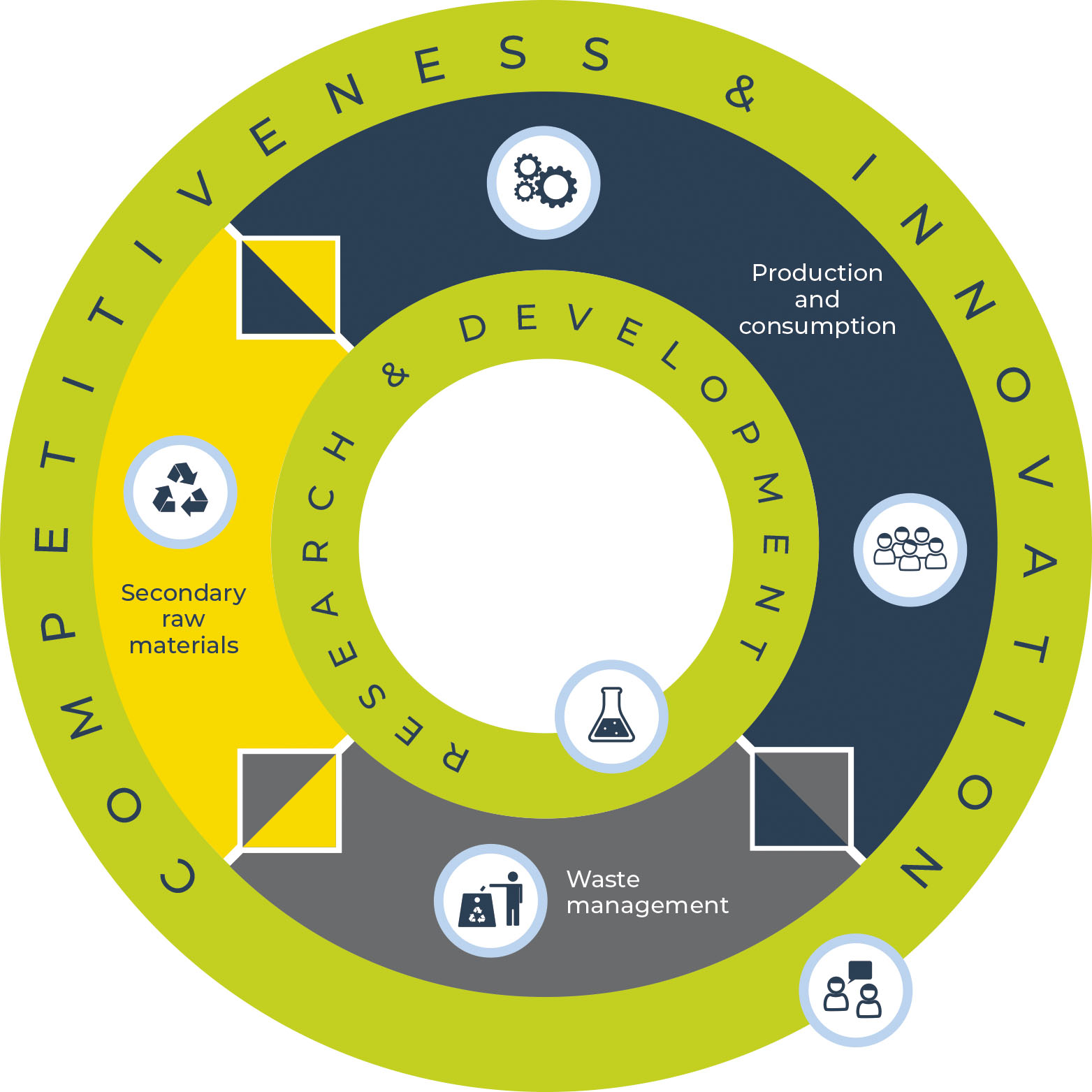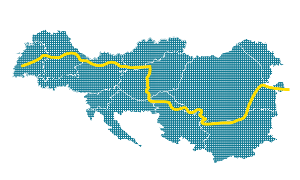THE DANUBE GOES CIRCULAR
Transnational Strategy to Accelerate Transition Towards a Circular Economy in the Danube Region
Tina Krošelj and Lara Habič, MESP
Within EU policy, the circular economy is increasingly recognised as a necessity rather than an option. The Danube region is geographically, economically and culturally diverse EU macro region, with many attributes that can appear as challenges or present opportunities. With measuring the circular and sustainable performances of the Danube region countries, the MOVECO project consortium prepared a transnational strategy with identified challenges, prepared strategic objectives and formulated sets of recommendations to accelerate transition towards a circular economy in the Danube region.
Key Challenges identified with regards to the transition of the Danube region towards a circular economy
From the analysis of the indicators prepared by MOVECO consortium, one main and 16 other challenges have been identified [1]. A comprehensive analysis report on challenge identification can be found in the Chapter VI of the The Danube Goes Circular transnational strategy and accompanying Appendix 2. This article presents only the summary of the identified challenges for the three stages of the circular economy encompassed by competitiveness and innovation.

The aspect of competitiveness and innovation
The region displays a slow but constant increase of competitiveness in the circular economy sector. Spending on research and development (R&D) has risen but is still rather low compared to the EU average. The eco-innovation index shows increased performance, although it is based on incremental improvements to existing technologies rather than radical base level innovations.
Lack of cooperation between small and medium-sized enterprises (SMEs) and R&D organisations was identified as one of the biggest challenges. It was noted, though, that there has been some improvement in public and private sector cooperation due to the development of consortiums for common projects and clusters.
To date, extended producer responsibility (EPR) which was created as a strategy, to support better design and boost eco-innovation for managing postconsumer waste streams, has fallen short of this objective in the Danube region countries, with no incentives to support better product design for better resource management.
Production and consumption
Currently, not only the Danube region, but the whole EU is resource poor and dependent on imports of many raw materials that are crucial for a strong industrial base, highlighting the need for more secure access, diversification of supply, and increased resource efficiency. Nevertheless, Danube region countries can be found on a map of average EU production of primary critical raw materials (CRMs) and their share of supply to EU [2].
Progress can be observed towards more circular trends in consumption, especially in terms of lower municipal waste generation, but consumer trust in products containing recycled materials and reused products is low. Producers have not yet accepted the necessity of better design for the environment (eco-design), requiring a need of increased awareness and knowledge on the part of both consumers and the business community regarding these issues.
Waste management
Many national activities still focus on the improvement of municipal waste management infrastructure, neglecting the need to support better design. Extended producer responsibility compliance schemes, also known as producer responsibility organisations (PROs) can contribute greatly to improving the supply of recycled plastic materials and CRMs from waste streams. Right now this is not the case, PROs being complicated and non-transparent.
Analysis of PROs in the Danube region [12] shows that for waste electrical and electronic equipment (WEEE) and waste batteries and accumulators (WBA) PROs are less complicated, usually fewer in number and more straightforward and transparent as packaging PROs. None of DR countries, except Germany, has already established modulated fees paid by producers for packaging waste management according to recyclability. Furthermore, in most of the DR countries, multiple collective PROs fulfilling the EPR obligations in the name of producers compete on the market. Consequently costs for managing a tonne of waste may not reflect an actual waste management cost per material category, which could actually lead to the collapse of the national waste management systems operation.
Secondary raw materials
Imports of secondary raw materials to the DR countries both from EU-28 and non-EU countries are increasing. Exports to non-EU countries are decreasing. According to the analysis made under the scope of the MOVECO project, trade in secondary raw materials hidden in transboundary shipments of waste among all nine DR countries is rather strong. Unfortunately, information on more detailed trade statistics was generally difficult to obtain. When available, data in general showed that packaging waste is traded almost equally among all nine DR countries, and more so among neighbouring countries.
Strategic objectives and set of recommendations
The main objective of the transnational strategy for the Danube region is to increase the resource efficiency while creating a circular business environment in the region. To protect raw material supply and increase resource efficiency, waste management should be connected with resource management. Though, material recycling plays an important role in circular economy transition, in July 2018, a revised waste legislative framework reinforces rules to strengthen waste prevention.
Highlighted recommendations
Exchange of information and best practices, cooperation and learning are key aspects of the transition phase. To improve resource efficiency, cooperation within the value chain needs to be strengthened and transparency increased from product design onwards. Transparency and communication along the whole value chains is most urgently needed to track material flows, especially additives, legacy and hazardous substances, which affect the quality of recycled materials.
Transparency must be complemented with better waste collection and higher quality pre-processing and dismantling, contributing to the establishment of a market for secondary raw materials through improved quality of these materials, especially within MOVECO three designated waste streams.
More resources need to be invested in research and development linked to market requirements. Future European Union funding instruments are expected to continue to provide finance for waste management infrastructure implementing technological improvements in pre-processing and recycling.
Extended producer responsibility (EPR) was created as a strategy to support better design and boosting eco-innovation for managing post-consumer waste streams, but has fallen short of its objective within the region. Due to a large share of component manufacturers and foreign ownership, many small and medium enterprises (smes) do not feel in control of design; this process works against the establishment of a circular economy. EPR schemes can facilitate design for recyclability and disassembly through eco-modulation of fees payed by producers to producer responsibility organisations (pros), reflecting actual waste management cost in a more transparent manner. EPR must also support an increase in consumer awareness.
Clearer eco-design requirements need to support eco-innovation in production and waste management value chains, facilitating cooperation. In addition to recycling targets, the importance of waste prevention will increase through quantified targets for improved product durability, reusability, and repairability. These are additional requirements which will need to be mirrored within future EPR measures in all Danube region countries.
A VISION – THE DANUBE GOES CIRCULAR
In 2030, the Danube region is an innovative, socially responsible and well governed European macro region with evident progress towards a circular economy.

[1] THE DANUBE GOES CIRCULAR – Transnational Strategy to Accelerate Transition Towards a Circular Economy in the Danube Region, Appendix 3, 2019, 55–57. http://www.interreg-danube.eu/uploads/media/approved_project_output/0001...
[2] Report: Critical Raw Materials and the Circular Economy (part 1), SWD/2018/036 final, Commission staff working document, Publications, European Commission, 2018. https://ec.europa.eu/commission/publications/report-critical-raw-materia....

